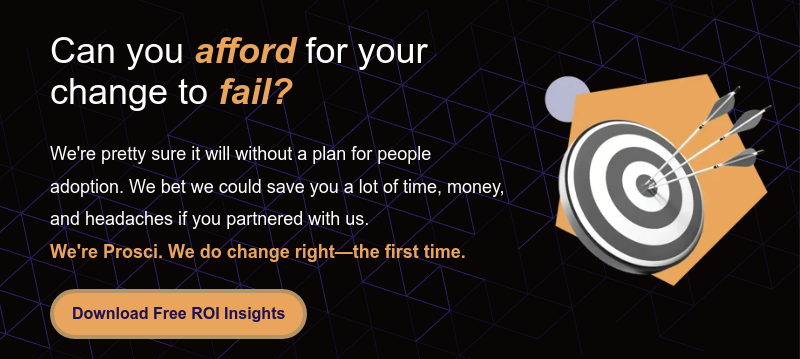The Power of Root Cause Analysis and Change Management

9 Mins
Updated: July 16, 2025
Published: December 1, 2024

Even the most well-planned organizational projects can encounter problems. But here's a question: Are you addressing the symptoms or tackling the root cause? Without digging deeper, many organizations fall into the trap of implementing temporary fixes that don’t last.
This is where root cause analysis (RCA) comes in. By systematically investigating problems, you can uncover the underlying issues, fix them, and prevent them from reoccurring. This systematic approach addresses resistance and systemic challenges, enabling smoother change transitions.
Though RCA is primarily used for technical or operational challenges, it plays a pivotal role in change management. It can help solve core issues that hinder the implementation of new initiatives and allow organizations to meet their change objectives.
This article explains root cause analysis, when to use it, and popular RCA methods. Then, we explore how RCA is used in change management and the process of conducting an analysis for a change project.
What Is Root Cause Analysis?
Root cause analysis is a process designed to identify the underlying cause of a problem or incident. RCA aims to uncover the fundamental issue that, when resolved, prevents the problem from recurring.
Organizations use a structured process to conduct a root cause analysis. They assess all factors related to a problem to define and fix the real source. Multiple root causes can exist for a single problem, and RCA digs into all contributing factors.
The goal is to implement solutions that prevent future occurrences, not just mitigate current impacts.
RCA is a critical business process for identifying project breakdowns and technical issues. Once root causes are identified and action plans developed, change management approaches can then support the work necessary to implement solutions effectively, particularly when those solutions require people to change their behaviors or adopt new processes.
Not all problems require an in-depth RCA. But sometimes the size and scope of the problem make RCA techniques indispensable.
When to Use Root Cause Analysis
A root cause analysis is a valuable tool to solve problems or prevent them in several scenarios:
- Recurring problems – If the same issue happens repeatedly, RCA helps uncover why it keeps returning and how to eliminate the actual root cause.
- Major incidents or failures – After critical system outages, server crashes or major process failures, root cause analysis helps find long-term solutions instead of quick fixes.
- High-impact issues – When an issue significantly affects operations, customers or revenue, RCA identifies the fundamental problem to prevent costly disruptions.
- Quality defects – Effective root cause analysis helps address quality issues that affect performance or customer satisfaction in manufacturing, IT or product development.
- Compliance or safety incidents – RCA ensures compliance and strengthens safety measures to prevent regulatory breaches, workplace accidents or security incidents.
- Customer complaints – A root cause analysis can examine patterns in customer feedback to identify and resolve systemic issues affecting the customer experience.
- Near misses – If an incident almost caused damage but was narrowly avoided, RCA helps address potential vulnerabilities before they escalate.
By applying RCA in these scenarios, organizations can address core issues that hinder change initiatives. There are many ways to conduct an RCA. Popular root cause analysis methods include the 5 Whys Technique, the Fishbone Diagram, and Causal Factor Analysis. Let’s take a closer look.
Root Cause Analysis Methods
How do you identify the root cause of a problem? The method you choose depends on the situation. Let’s explore a few proven techniques:
1. 5 Whys technique
Have you ever found yourself repeatedly asking "Why?" when an issue occurs? That’s the essence of this method. The 5 Whys root cause analysis technique is a simple, iterative approach that asks "Why?" repeatedly to find the root cause of a problem. It’s effective for straightforward issues where the underlying cause is not immediately evident.
For example, why did a project deadline slip? Because a key resource was unavailable. Why was the resource unavailable? Because scheduling conflicts weren’t addressed. Why were they not addressed? Keep asking until you hit the core issue.
2. Fishbone diagram
The Fishbone Diagram, or the Ishikawa Diagram, visually maps out potential causes of a problem. It resembles a fish skeleton, where the problem is depicted as the central spine of the fish. The variable causes for the problem are mapped out in the rest of the bones and categorized into groups like people, processes, technology and environment.
 This method is useful for analyzing complex problems with multiple contributing, interrelated factors and identifying specific root causes.
This method is useful for analyzing complex problems with multiple contributing, interrelated factors and identifying specific root causes.
3. Change analysis
When a system or process performance changes drastically, you can use change analysis to examine the differences between normal operations and the circumstances in which the problem occurred. The goal is to define which change triggered the issue.
The first step is defining the “normal state” or baseline. Then, the organization or team maps out changes and analyzes how they contributed to the issue.
You can also use this type of analysis before implementing a change to understand its potential impact.
4. Causal factor analysis
Causal factor analysis (CFA) or causal factor tree analysis records and visually displays the specific actions, omissions or conditions contributing to an undesired outcome.
The "tree" starts with the problem at the top, and the sequence of events leading to the issue is mapped out under it. Then, you identify the events or actions that, if removed, would have prevented the problem. These causal factors are further analyzed to identify the root cause.
5. Event analysis
Event analysis focuses on the sequence and timeline of events leading to a major incident or problem, like a server outage. This method is ideal for incidents involving multiple stages or interactions.
Here, your team creates a timeline of key events and analyzes their interactions to identify failures or disruptions. In the example of a server outage, the IT department can review system logs to pinpoint the triggering event.
Other popular root cause analysis tools include the Failure Mode and Effects Analysis (FMEA) and Pareto Analysis. While most RCA methods are tailored to address technical or operational failures, RCA is often used to improve change outcomes. Each method can uncover obstacles and improve the success of change management efforts.
The Link Between Root Cause Analysis and Change Management
Root cause analysis and change management complement each other to drive successful transformations. Change management is the use of a structured approach to manage the people side of change and achieve a desired outcome. It's not just about managing change—it's about empowering individuals to adapt, embrace and thrive in new realities.
Organizations use change management to guide technology upgrades, organizational restructuring, process improvements or cultural shifts. Its structured approach helps your organization transition smoothly, prevents resistance and keeps teams aligned on the path to success. And the stakes are high: organizational projects with effective change management are seven times more likely to meet or exceed their objectives.
Correlation of Change Management Effectiveness With Meeting Objectives

In organizational change, root cause analysis is a valuable tool for identifying the core issues that negatively impact a change project. Common reasons why change can fail include communication flaws and employee resistance.
Once root causes are identified through RCA, specialized change management approaches can help develop and implement appropriate solutions. For example, after identifying that a change initiative is struggling due to inadequate leadership support (the root cause), organizations can apply Prosci's research-backed sponsorship strategies to address this specific challenge.
Let's take a closer look at how RCA and change management work together during a change initiative.
Integrating Root Cause Analysis With Change Management
When change initiatives face challenges, a structured approach combining RCA with change management best practices can lead to optimal outcomes. Here's a four-step process for effectively addressing issues during change:
1. Determine the root cause
First, use appropriate RCA techniques to identify the fundamental issues impacting your change project. This could involve:
- Applying the 5 Whys technique to understand why employees are resisting a new system
- Using a Fishbone Diagram to map multiple factors contributing to low adoption rates
- Conducting an Event Analysis to understand where a change implementation went off track
The goal is to move beyond symptoms to understand the true causes of the problem.
2. Develop corrective action plans based on root causes
Once you've identified the root causes, develop targeted strategies to address them. For example:
- If poor communication is the root cause, redesign your communication approach to be more transparent and address specific concerns
- If inadequate training is identified as the issue, develop more comprehensive and accessible learning opportunities
- If the change design itself has flaws, involve end users in refining and improving the solution
3. Incorporate change management expertise
This is where specialized change management approaches become invaluable. After identifying root causes and developing initial plans, leverage proven change management frameworks to implement solutions effectively.
Prosci's research-backed methodology offers distinct advantages when implementing corrective actions:
- Structured approach: Prosci's methodology provides a clear framework for managing the people side of change
- Research foundation: Solutions based on decades of benchmarking studies and best practices
- Specialized tools: Targeted assessments and planning resources for specific change challenges
- Role-based guidance: Specific strategies for sponsors, managers, and change practitioners
For example, if your RCA reveals that managers aren't supporting a change effectively, Prosci's research on the manager's role in change can provide specific, proven strategies to address this issue.
4. Enable sponsors to implement the solution
Once you’ve developed a plan to address the root cause of resistance, you must work with sponsors and people managers to implement it.
Sponsors are leaders in charge of the change initiative. They authorize, participate in and support change activities to achieve positive outcomes.
People managers are mid-level managers or direct supervisors of the impacted individuals. They account for 70% of the variance in team employee engagement. Their attitudes and behaviors directly affect how employees view and participate in the change.
Practitioners must provide RCA information to managers and sponsors and support them in implementing corrective activities.
These four steps are a basic roadmap for identifying and solving core issues during change. To simplify and speed up the problem-solving process, use our basic, structured Root Cause Analysis template and customize it to match your specific change project.
The Benefits of Integrating Root Cause Analysis and Change Management
While we’ve covered the main use of root cause analysis during change, there are nine general benefits that organizations can achieve by integrating RCA and change management:

1. Look past surface-level problems
Change initiatives often fail because they focus on surface-level problems without addressing the fundamental factors driving them. Combining RCA with change management enables you to address the root cause of issues rather than treating the symptoms.
For example, a company might believe that new software will fix low productivity. However, an RCA might reveal that the real root cause is inadequate employee training. To solve this, they can implement change management techniques like tailored training programs, leading to lasting improvements. Alternatively, a company may assume that hiring additional staff will alleviate delays in project delivery. However, an RCA might uncover that the actual issue lies in unclear processes and lack of standard operating procedures. To address this, they can apply change management strategies such as process mapping and documentation initiatives, which will streamline workflows and enhance overall efficiency.
2. Enhance risk mitigation
RCA helps identify potential risks early by analyzing past failures or near-miss incidents, allowing organizations to build preventative measures into the change management process.
For example, a root cause analysis during a large-scale digital transformation can reveal that the previous ERP system upgrade failed due to poor stakeholder engagement. Change management teams can use this insight to engage people early, reducing the likelihood of failure.
3. Drive sustainable change
A holistic approach guarantees changes lead to long-term improvements rather than short-term patches that result in repeated problems. Sustaining change is more cost-effective than having to start from scratch with new initiatives, increases the likelihood of project success, and helps ensure the project fully realizes its intended benefits.
4. Improve stakeholder confidence
Stakeholders, from executives to front-line employees, are more likely to support a change based on analysis and data-driven insights.
RCA provides the evidence to justify the change, while change management ensures that stakeholders are engaged and informed throughout the process. This combination fosters greater trust, transparency and collaboration within the organization.
5. Increase efficiency and cost savings
Addressing the wrong problem can waste time, effort and financial resources. By preventing unnecessary or misdirected change initiatives, companies can save significant costs and boost operational efficiency.
For example, the root cause analysis identifies that frequent IT outages are caused by misconfigured servers, not the aging hardware as initially suspected. Good change management facilitates proper reconfiguration, avoiding unnecessary hardware investments.
6. Provide continuous improvement and learning
Integrating root cause analysis and change management builds a culture of continuous improvement by encouraging organizations to learn from past failures and refine processes. Change management embeds the lessons from RCA into everyday operations.
Over time, this approach leads to organizational maturity, resilience and adaptability in the face of evolving challenges.
7. Strengthen alignment with organizational goals
RCA helps organizations identify how operational issues align with broader business objectives, ensuring that change management initiatives support strategic goals. This alignment maximizes the impact of changes and drives measurable outcomes.
By focusing on the root cause, organizations can prioritize changes that drive competitive advantage and growth.
For example, the RCA reveals that inefficient supply chain processes are causing delayed product launches. The organization then applies supply chain change management to implement business process automation, aligning with the company's goal of faster time-to-market.
8. Improve employee engagement and morale
Only 23% of the global workforce is engaged, and maintaining employee engagement during change is challenging. To engage with and help employees embrace change, you can use RCA to get insights into employee pain points and implement changes that address their problems. This improves job satisfaction and reduces turnover, contributing to a healthier workplace culture.
9. Enhance scalability and flexibility
By applying RCA tools and resources, like our ADKAR Model, organizations can identify systemic issues and use change management methodologies to implement scalable solutions. The Prosci 10 aspects of change impact is another useful framework that can significantly assist with root cause analysis during change initiatives. It provides a structured way to assess the various dimensions of how individuals and groups are affected by the change.
This leads to a flexible and resilient organization that can effectively adapt to growth, market shifts and technological advancements. Scalable RCA solutions enable organizations to address systemic challenges and adapt to growth.
Prosci Helps You Solve Problems During Change
Root cause analysis and change management work hand-in-hand to drive sustainable success. Prosci supports organizations in balancing RCA with effective change strategies.
Conducting a root cause analysis is a crucial piece of the puzzle for driving successful change in your organization. However, we understand that balancing this analysis with the planning, implementation, and sustainment of your change initiatives can be daunting, especially if you're navigating this terrain with limited change management expertise and resources.
That's where Prosci can help. Our team of expert advisors and comprehensive change management methodology complement your root cause analysis efforts with research-backed strategies specifically designed for the people side of change. Together, we can translate your RCA insights into targeted action plans that drive successful adoption and sustainable results.
By combining root cause analysis with Prosci's specialized change management expertise, you'll not only identify what's going wrong but also implement proven solutions that address the unique challenges of managing change in your organization.





